transmission MITSUBISHI iMiEV 2016 1.G Owners Manual
[x] Cancel search | Manufacturer: MITSUBISHI, Model Year: 2016, Model line: iMiEV, Model: MITSUBISHI iMiEV 2016 1.GPages: 296, PDF Size: 7.79 MB
Page 11 of 296
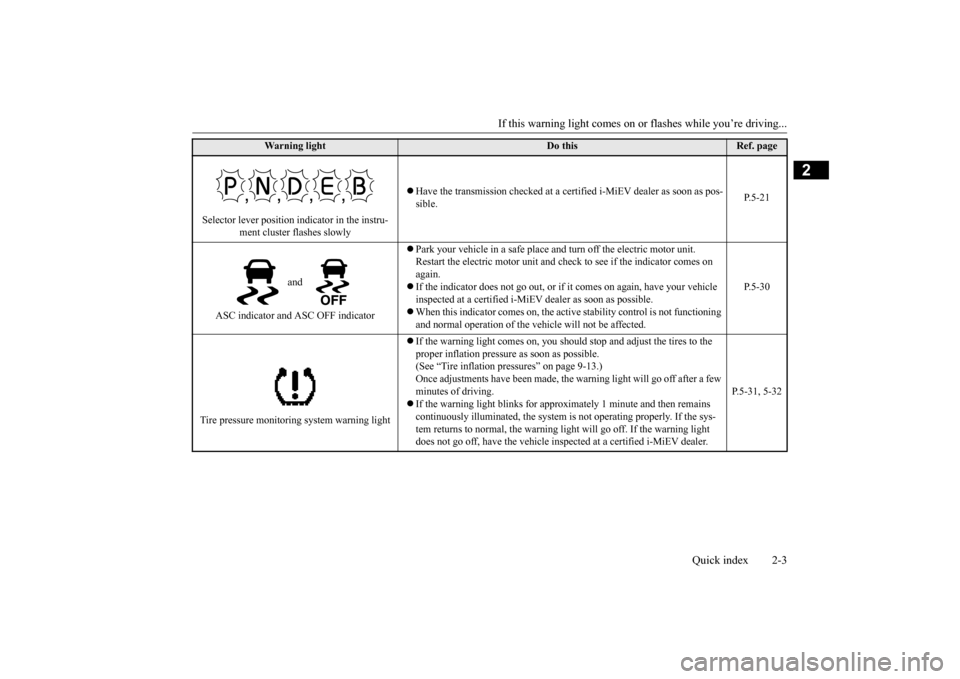
If this warning light comes on or
flashes while you’re driving...
Quick index 2-3
2
Selector lever position indicator in the instru-
ment cluster flashes slowly
Have the transmission checked at a cert
ified i-MiEV dealer as soon as pos-
sible.
P.5-21
and
ASC indicator and ASC OFF indicator
Park your vehicle in a safe place a
nd turn off the electric motor unit.
Restart the electric motor unit and check to see if the indicator comes on again. If the indicator does not go out, or if it
comes on again, have your vehicle
inspected at a certified i-MiEV
dealer as soon as possible.
When this indicator comes on, the acti
ve stability contro
l is not functioning
and normal operation of the vehi
cle will not be affected.
P.5-30
Tire pressure monitoring system warning light
If the warning light comes on, you shoul
d stop and adjust the tires to the
proper inflation pressure
as soon as possible.
(See “Tire inflation pr
essures” on page 9-13.)
Once adjustments have been made, the
warning light will go off after a few
minutes of driving. If the warning light blinks for appr
oximately 1 minute and then remains
continuously illuminated, the system is
not operating properly. If the sys-
tem returns to normal, the warning li
ght will go off. If the warning light
does not go off, have the vehicle insp
ected at a certified i-MiEV dealer.
P.5-31, 5-32
Warning light
Do this
Ref. page
BK0220401US.book 3 ページ 2015年6月3日 水曜日 午前7時42分
Page 13 of 296
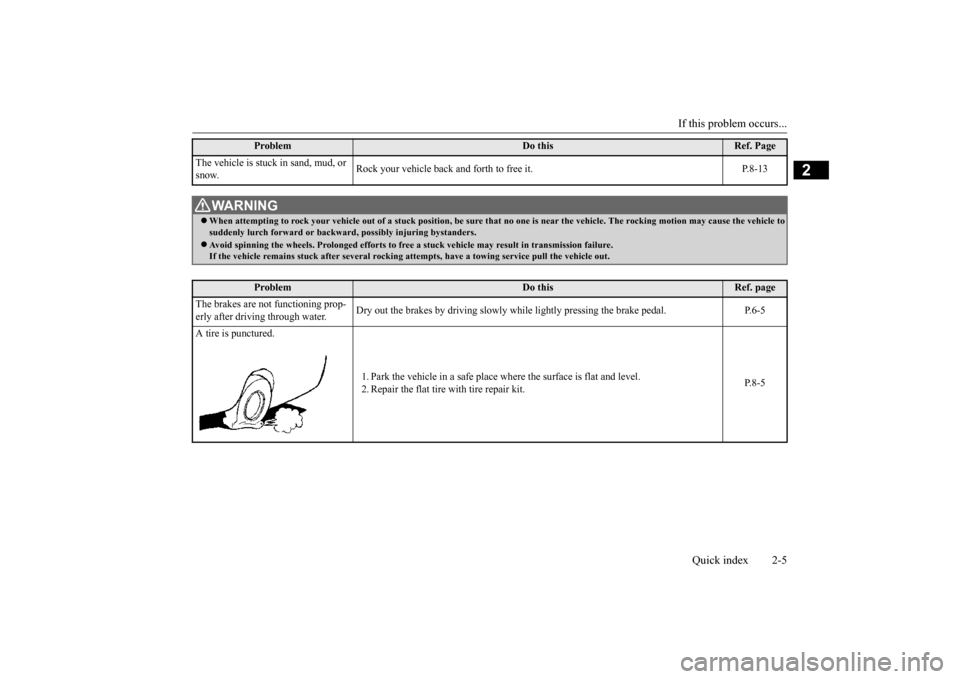
If this problem occurs...
Quick index 2-5
2
The vehicle is stuck
in sand, mud, or
snow.
Rock your vehicle back and forth to free it. P.8-13
WA R N I N G When attempting to rock your vehicle out of
a stuck position, be sure that
no one is near the vehicl
e. The rocking motion may c
ause the vehicle to
suddenly lurch forward or backward, possibly injuring bystanders. Avoid spinning the wheels. Prolonged efforts to free
a stuck vehicle may result
in transmission failure.
If the vehicle remains stuck after several rocking attempts, have a towing service pull the vehicle out.
Problem
Do this
Ref. page
The brakes are not functioning prop- erly after driving through water.
Dry out the brakes by driving slowly whil
e lightly pressing the brake pedal. P.6-5
A tire is punctured.
1. Park the vehicle in a safe place where the surface is flat and level. 2. Repair the flat tire with tire repair kit.
P.8-5
Problem
Do this
Ref. Page
BK0220401US.book 5 ページ 2015年6月3日 水曜日 午前7時42分
Page 58 of 296
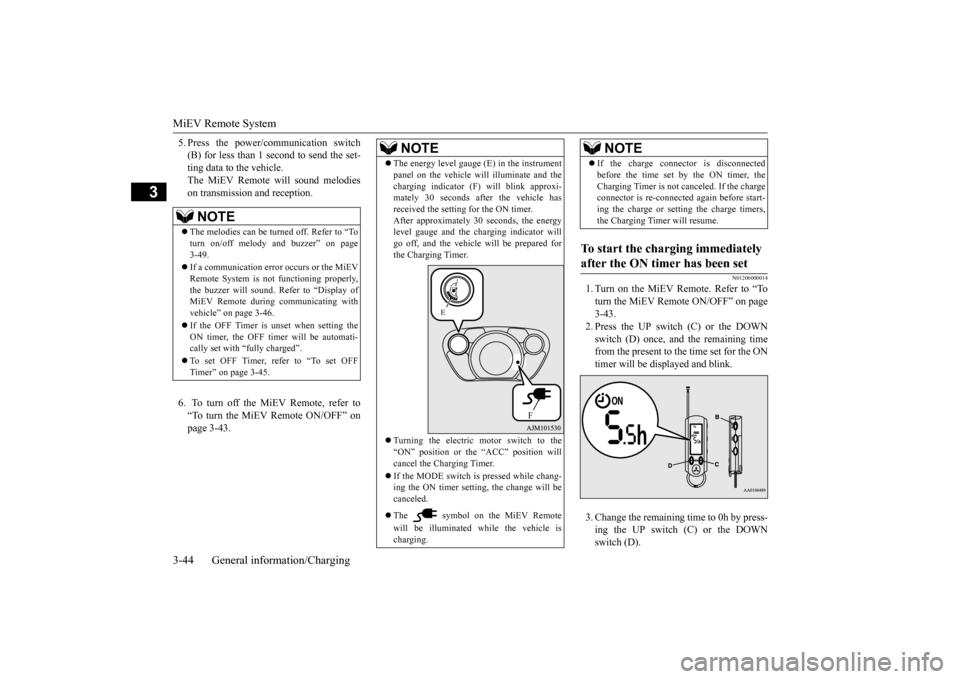
MiEV Remote System 3-44 General information/Charging
3
5. Press the power/communication switch (B) for less than 1 second to send the set-ting data to the vehicle. The MiEV Remote will sound melodies on transmission and reception. 6. To turn off the MiEV Remote, refer to “To turn the MiEV Remote ON/OFF” on page 3-43.
N01206000014
1. Turn on the MiEV Remote. Refer to “Toturn the MiEV Remote ON/OFF” on page3-43. 2. Press the UP switch (C) or the DOWN switch (D) once, and the remaining timefrom the present to the time set for the ON timer will be disp
layed and blink.
3. Change the remainin
g time to 0h by press-
ing the UP switch (C) or the DOWN switch (D).
NOTE
The melodies can be turned off. Refer to “To turn on/off melody
and buzzer” on page
3-49. If a communication error occurs or the MiEV Remote System is not
functioning properly,
the buzzer will sound. Refer to “Display of MiEV Remote during communicating with vehicle” on page 3-46. If the OFF Timer is unset when setting the ON timer, the OFF timer will be automati-cally set with “f
ully charged”.
To set OFF Timer, refer to “To set OFF Timer” on page 3-45.
NOTE
The energy level gauge (E) in the instrument panel on the vehicle wi
ll illuminate and the
charging indicator (F
) will blink approxi-
mately 30 seconds af
ter the vehicle has
received the setting for the ON timer. After approximately 30 seconds, the energylevel gauge and the charging indicator will go off, and the vehicle will be prepared for the Charging Timer. Turning the electric motor switch to the “ON” position or th
e “ACC” position will
cancel the Charging Timer. If the MODE switch is pressed while chang- ing the ON timer setting,
the change will be
canceled. The symbol on the MiEV Remote will be illuminated while the vehicle is charging.
E
F
If the charge connect
or is disconnected
before the time set by the ON timer, theCharging Timer is not canceled. If the chargeconnector is re-connected
again before start-
ing the charge or setting the charge timers, the Charging Timer will resume.
To start the charging immediately after the ON timer has been set
NOTE
BK0220401US.book 44 ページ 2015年6月3日 水曜日 午前7時42分
Page 59 of 296
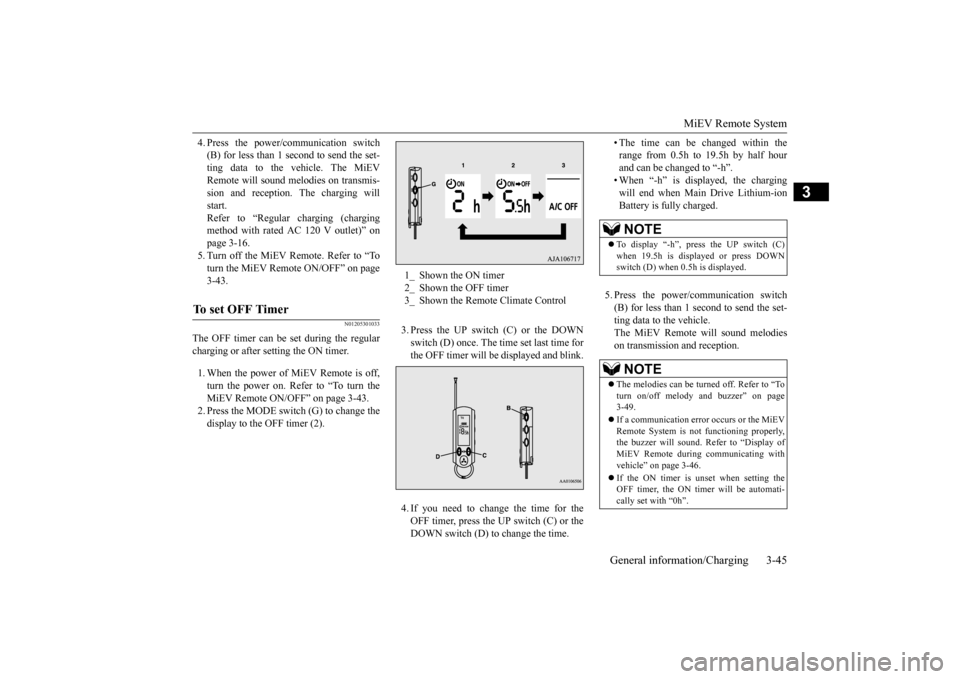
MiEV Remote System
General information/Charging 3-45
3
4. Press the power/c
ommunication switch
(B) for less than 1 second to send the set-ting data to the vehicle. The MiEV Remote will sound melodies on transmis- sion and reception. The charging willstart. Refer to “Regular charging (charging method with rated AC 120 V outlet)” onpage 3-16. 5. Turn off the MiEV Remote. Refer to “To turn the MiEV Remote ON/OFF” on page 3-43.
N01205301033
The OFF timer can be
set during the regular
charging or after setting the ON timer. 1. When the power of MiEV Remote is off, turn the power on. Refer to “To turn theMiEV Remote ON/OFF” on page 3-43. 2. Press the MODE switc
h (G) to change the
display to the OFF timer (2).
3. Press the UP switch (C) or the DOWN switch (D) once. The time set last time for the OFF timer will be
displayed and blink.
4. If you need to change the time for the OFF timer, press the UP switch (C) or the DOWN switch (D) to change the time.
• The time can be changed within the range from 0.5h to 19.5h by half hourand can be changed to “-h”. • When “-h” is displayed, the charging will end when Main Drive Lithium-ionBattery is fully charged.
5. Press the power/c
ommunication switch
(B) for less than 1 second to send the set- ting data to the vehicle.The MiEV Remote
will sound melodies
on transmission and reception.
To set OFF Timer
1_ Shown the ON timer 2_ Shown the OFF timer 3_ Shown the Remote Climate Control
NOTE
To display “-h”, press the UP switch (C) when 19.5h is displayed or press DOWN switch (D) when 0.5h is displayed.NOTE
The melodies can be turned off. Refer to “To turn on/off melody and buzzer” on page 3-49. If a communication error occurs or the MiEV Remote System is not
functioning properly,
the buzzer will sound. Refer to “Display ofMiEV Remote during
communicating with
vehicle” on page 3-46. If the ON timer is unset when setting the OFF timer, the ON timer will be automati- cally set with “0h”.
BK0220401US.book 45 ページ 2015年6月3日 水曜日 午前7時42分
Page 63 of 296
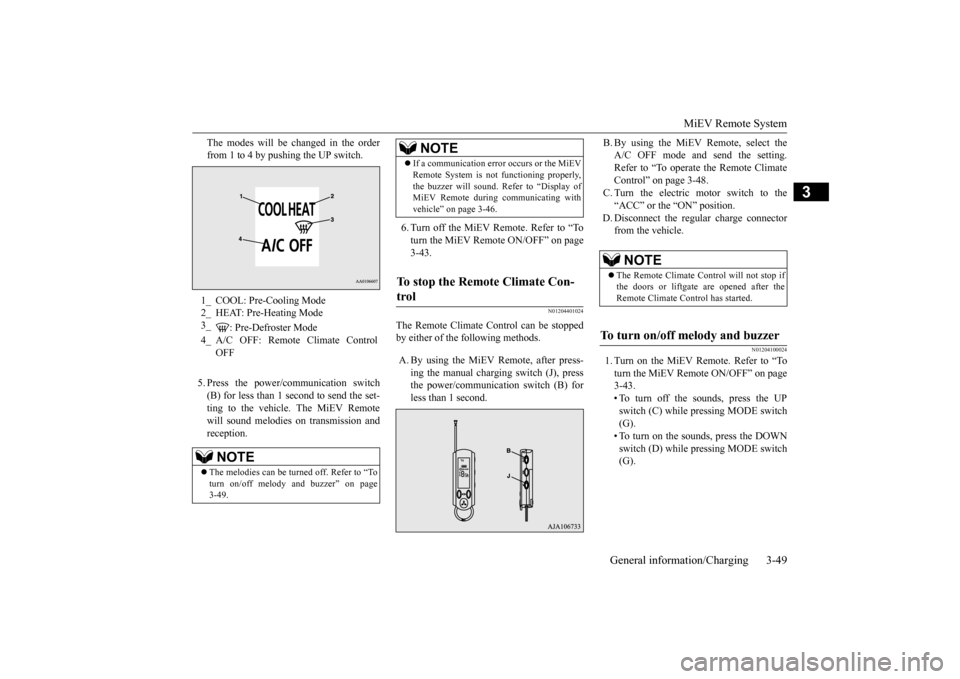
MiEV Remote System
General information/Charging 3-49
3
The modes will be changed in the order from 1 to 4 by pushing the UP switch. 5. Press the power/c
ommunication switch
(B) for less than 1 second to send the set- ting to the vehicle. The MiEV Remotewill sound melodies
on transmission and
reception.
6. Turn off the MiEV Remote. Refer to “To turn the MiEV Remote ON/OFF” on page 3-43.
N01204401024
The Remote Climate C
ontrol can be stopped
by either of the following methods. A. By using the MiEV Remote, after press-
ing the manual charging switch (J), press the power/communication switch (B) forless than 1 second.
B. By using the MiEV Remote, select the A/C OFF mode and send the setting.Refer to “To operate the Remote Climate Control” on page 3-48. C. Turn the electric motor switch to the“ACC” or the “ON” position.
D. Disconnect the regular charge connector
from the vehicle.
N01204100024
1. Turn on the MiEV Remote. Refer to “Toturn the MiEV Remote ON/OFF” on page3-43. • To turn off the sounds, press the UP switch (C) while pressing MODE switch(G). • To turn on the sounds, press the DOWN switch (D) while pressing MODE switch(G).
1_ COOL: Pre-Cooling Mode 2_ HEAT: Pre-Heating Mode3_
: Pre-Defroster Mode
4_ A/C OFF: Remote Climate Control
OFFNOTE
The melodies can be turned off. Refer to “To turn on/off melody and buzzer” on page 3-49.
If a communication error occurs or the MiEV Remote System is not
functioning properly,
the buzzer will sound. Refer to “Display ofMiEV Remote during communicating with vehicle” on page 3-46.
To stop the Remote Climate Con- trol
NOTE
NOTE
The Remote Climate Control will not stop if the doors or liftgate are opened after the Remote Climate Control has started.
To turn on/off melody and buzzer
BK0220401US.book 49 ページ 2015年6月3日 水曜日 午前7時42分
Page 129 of 296
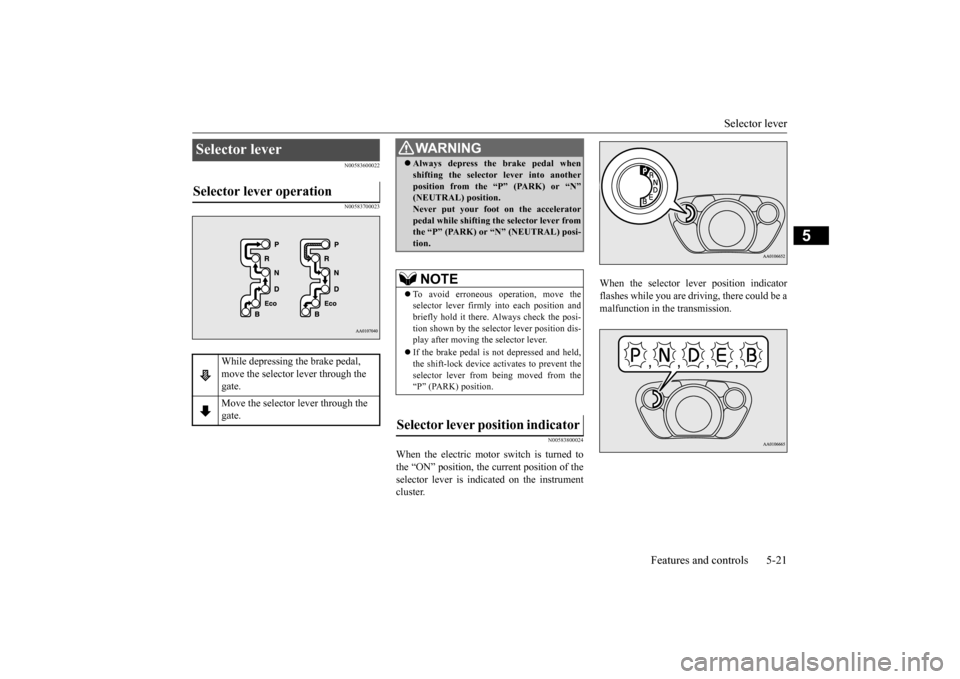
Selector lever
Features and controls 5-21
5
N00583600022 N00583700023
N00583800024
When the electric motor switch is turned to the “ON” position, the current position of the selector lever is indi
cated on the instrument
cluster.
When the selector le
ver position indicator
flashes while you are driv
ing, there could be a
malfunction in the transmission.
Selector lever Selector lever operation
While depressing the brake pedal, move the selector lever through the gate. Move the selector lever through the gate.
WA R N I N G Always depress the brake pedal when shifting the selector
lever into another
position from the
“P” (PARK) or “N”
(NEUTRAL) position. Never put your foot on the accelerator pedal while shifting the selector lever fromthe “P” (PARK) or
“N” (NEUTRAL) posi-
tion.NOTE
To avoid erroneous
operation, move the
selector lever firmly into each position andbriefly hold it there. Always check the posi- tion shown by the select
or lever position dis-
play after moving the selector lever. If the brake pedal is not depressed and held, the shift-lock device activates to prevent theselector lever from being moved from the “P” (PARK) position.
Selector lever po
sition indicator
BK0220401US.book 21 ページ 2015年6月3日 水曜日 午前7時42分
Page 130 of 296
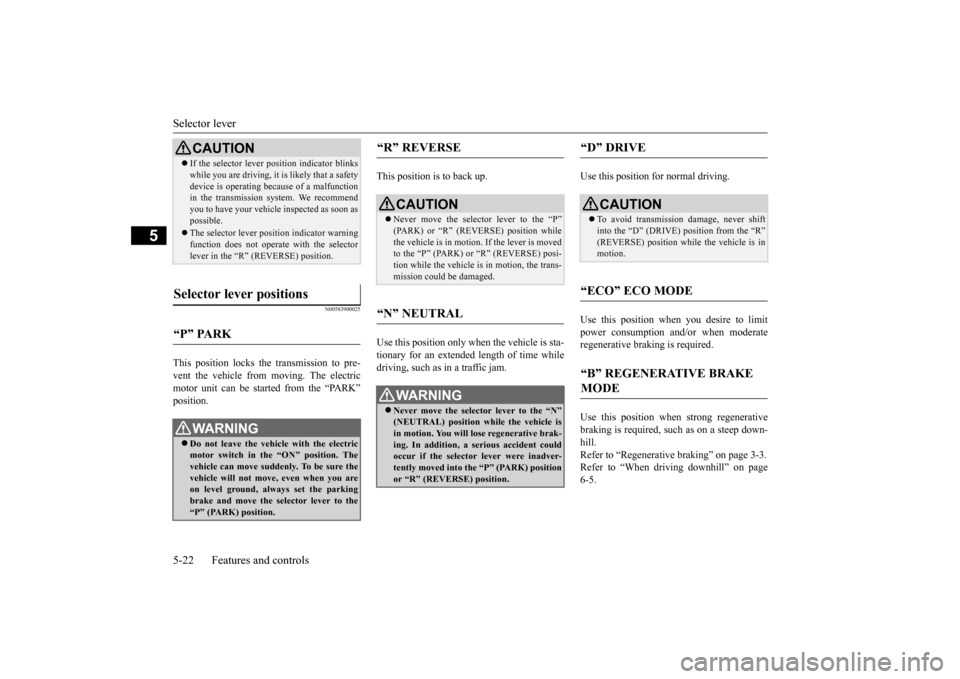
Selector lever 5-22 Features and controls
5
N00583900025
This position locks the transmission to pre- vent the vehicle from moving. The electric motor unit can be started from the “PARK” position.
This position is to back up. Use this position only wh
en the vehicle is sta-
tionary for an extended length of time while driving, such as in a traffic jam.
Use this position for normal driving. Use this position when you desire to limit power consumption and/or when moderateregenerative braking is required. Use this position when strong regenerative braking is required, such as on a steep down-hill. Refer to “Regenerative braking” on page 3-3. Refer to “When driving downhill” on page6-5.
CAUTION If the selector lever pos
ition indicator blinks
while you are driving, it
is likely that a safety
device is operating be
cause of a malfunction
in the transmission system. We recommend you to have your vehicle inspected as soon as possible. The selector lever posit
ion indicator warning
function does not operate with the selectorlever in the “R”
Selector lever positions “P” PARK
WA R N I N GDo not leave the vehicle with the electric motor switch in the “ON” position. The vehicle can move suddenly. To be sure the vehicle will not move,
even when you are
on level ground, alw
ays set the parking
brake and move the se
lector lever to the
“P” (PARK) position.
“R” REVERSE
CAUTION Never move the selector lever to the “P” (PARK) or
Page 131 of 296
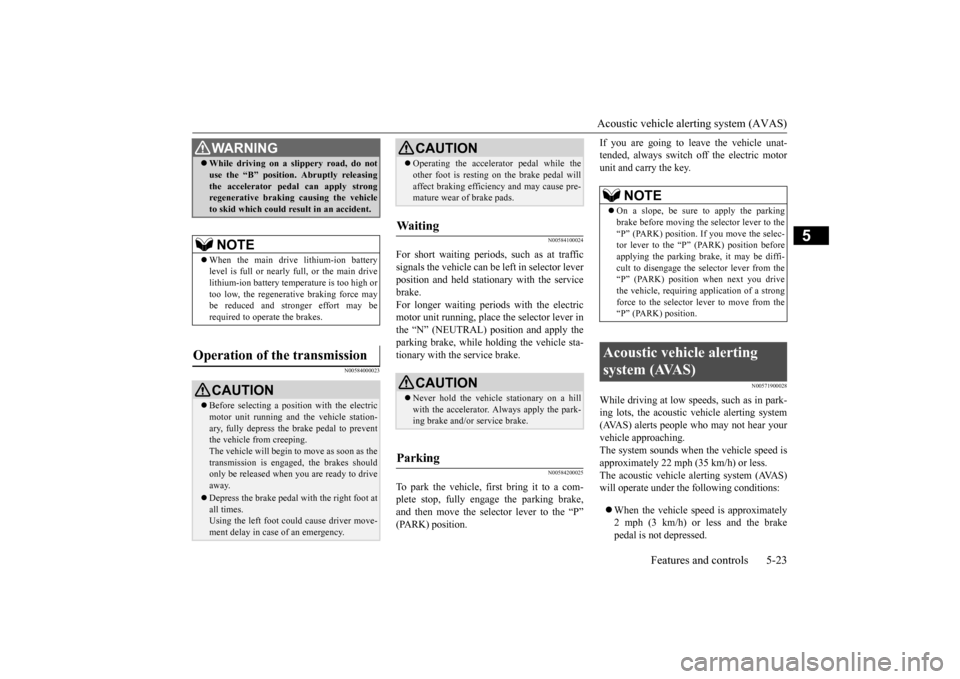
Acoustic vehicle alerting system (AVAS)
Features and controls 5-23
5
N00584000023
N00584100024
For short waiting periods, such as at traffic signals the vehicle can be
left in selector lever
position and held stationary with the service brake. For longer waiting periods with the electricmotor unit running, plac
e the selector lever in
the “N” (NEUTRAL) position and apply the parking brake, while holding the vehicle sta-tionary with the service brake.
N00584200025
To park the vehicle, first bring it to a com-plete stop, fully engage the parking brake, and then move the selector lever to the “P” (PARK) position.
If you are going to leave the vehicle unat- tended, always switch
off the electric motor
unit and carry the key.
N00571900028
While driving at low speeds, such as in park-ing lots, the acoustic vehicle alerting system(AVAS) alerts people who may not hear your vehicle approaching. The system sounds when the vehicle speed isapproximately 22 mph
(35 km/h) or less.
The acoustic vehicle alerting system (AVAS) will operate under th
e following conditions:
When the vehicle sp
eed is approximately
2 mph (3 km/h) or less and the brake pedal is not depressed.
WA R N I N G While driving on a slippery road, do not use the “B” position.
Abruptly releasing
the accelerator pedal can apply strongregenerative braking
causing the vehicle
to skid which could result in an accident.NOTE
When the main drive lithium-ion battery level is full or nearly
full, or the main drive
lithium-ion battery temp
erature is too high or
too low, the regenerative braking force may be reduced and stronger effort may berequired to operate the brakes.
Operation of the transmission
CAUTION Before selecting a pos
ition with the electric
motor unit running and the vehicle station- ary, fully depress the brake pedal to prevent the vehicle from creeping.The vehicle will begin to move as soon as the transmission is engage
d, the brakes should
only be released when you are ready to driveaway. Depress the brake pedal
with the right foot at
all times. Using the left foot could cause driver move- ment delay in case of an emergency.
Operating the accelerator pedal while the other foot is resting
on the brake pedal will
affect braking efficien
cy and may cause pre-
mature wear of brake pads.
Waiting
CAUTION Never hold the vehicle
stationary on a hill
with the accelerator. Always apply the park- ing brake and/or service brake.
Parking
CAUTION
NOTE
On a slope, be sure to apply the parking brake before moving the selector lever to the“P” (PARK) position. If you move the selec- tor lever to the
Page 230 of 296
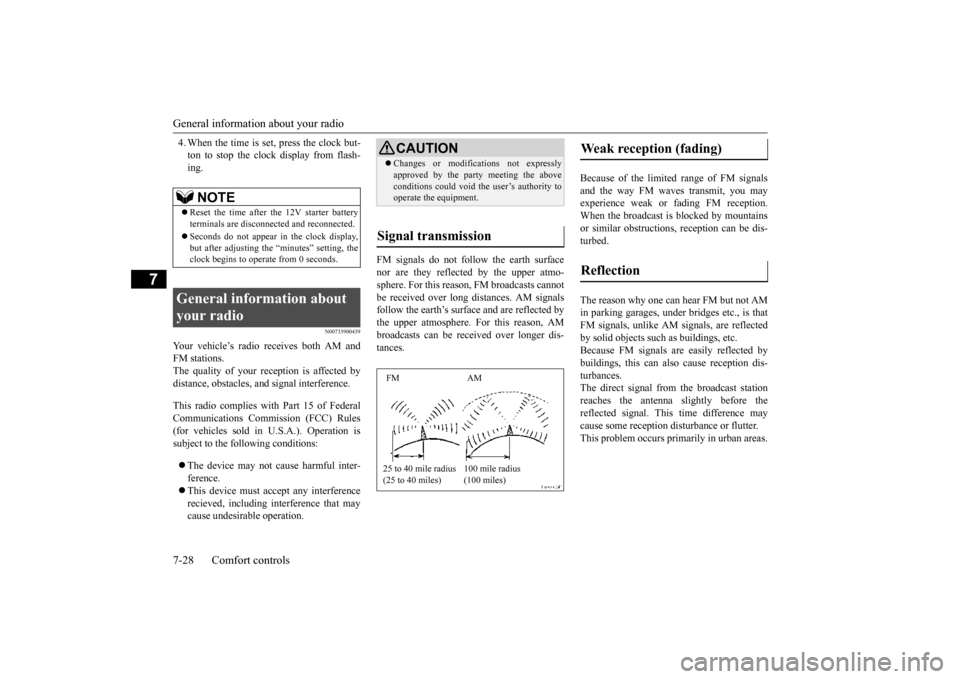
General information about your radio 7-28 Comfort controls
7
4. When the time is set, press the clock but- ton to stop the clock display from flash-ing.
N00733900439
Your vehicle’s radio receives both AM andFM stations. The quality of your reception is affected by distance, obstacles, an
d signal interference.
This radio complies with Part 15 of Federal Communications Commission (FCC) Rules (for vehicles sold in U.S.A.). Operation is subject to the following conditions: The device may not cause harmful inter- ference. This device must ac
cept any interference
recieved, including interference that maycause undesirable operation.
FM signals do not follow the earth surface nor are they reflected by the upper atmo-sphere. For this reason,
FM broadcasts cannot
be received over long distances. AM signals follow the earth’s surface and are reflected bythe upper atmosphere. For this reason, AM broadcasts can be received over longer dis- tances.
Because of the limite
d range of FM signals
and the way FM waves transmit, you may experience weak or fading FM reception.When the broadcast is blocked by mountains or similar obstructions,
reception ca
n be dis-
turbed. The reason why one can hear FM but not AM in parking garages, unde
r bridges etc., is that
FM signals, unlike AM
signals, are reflected
by solid objects such
as buildings, etc.
Because FM signals are easily reflected by buildings, this can also
cause reception dis-
turbances.The direct signal from
the broadcast station
reaches the antenna slightly before the reflected signal. This
time difference may
cause some reception di
sturbance or flutter.
This problem occurs primarily in urban areas.
NOTE
Reset the time after the 12V starter battery terminals are disconnect
ed and reconnected.
Seconds do not appear
in the clock display,
but after adjusting the
“minutes” setting, the
clock begins to opera
te from 0 seconds.
General information about your radio
CAUTION Changes or modifica
tions not expressly
approved by the party meeting the aboveconditions could void th
e user’s authority to
operate the equipment.
Signal transmission FM AM 25 to 40 mile radius (25 to 40 miles)
100 mile radius (100 miles)
Weak reception (fading) Reflection
BK0220401US.book 28 ページ 2015年6月3日 水曜日 午前7時42分
Page 245 of 296
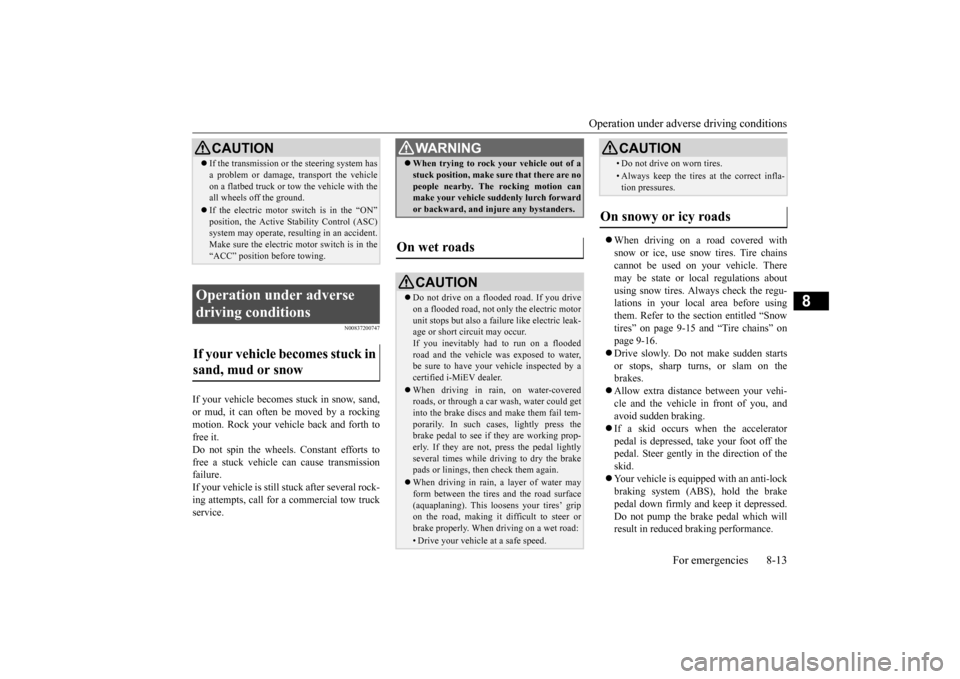
Operation under adverse driving conditions
For emergencies 8-13
8
N00837200747
If your vehicle becomes stuck in snow, sand, or mud, it can often be moved by a rocking motion. Rock your vehicle back and forth tofree it. Do not spin the wheels. Constant efforts to free a stuck vehicle can cause transmissionfailure. If your vehicle is still
stuck after several rock-
ing attempts, call for a commercial tow truckservice.
When driving on a road covered with snow or ice, use snow tires. Tire chains cannot be used on your vehicle. Theremay be state or local regulations about using snow tires. Always check the regu- lations in your local area before usingthem. Refer to the section entitled “Snow tires” on page 9-15 and “Tire chains” on page 9-16. Drive slowly. Do not make sudden starts or stops, sharp turns, or slam on the brakes. Allow extra distance between your vehi- cle and the vehicle in front of you, and avoid sudden braking. If a skid occurs when the accelerator pedal is depressed, take your foot off the pedal. Steer gently in the direction of theskid. Your vehicle is equippe
d with an anti-lock
braking system (ABS), hold the brakepedal down firmly and
keep it depressed.
Do not pump the brake pedal which will result in reduced braking performance.
CAUTION If the transmission or the steering system has a problem or damage,
transport the vehicle
on a flatbed truck or to
w the vehicle with the
all wheels off the ground. If the electric motor switch is in the “ON”
lting in an accident.
Make sure the electric motor switch is in the“ACC” position before towing.
Operation under adverse driving conditions If your vehicle becomes stuck in sand, mud or snow
WA R N I N G When trying to rock
your vehicle out of a
stuck position, make sure that there are nopeople nearby. The
rocking motion can
make your vehicle suddenly lurch forward or backward, and inju
re any bystanders.
On wet roads
CAUTIONDo not drive on a flooded road. If you drive on a flooded road, not only the electric motorunit stops but also a fail
ure like electric leak-
age or short circuit may occur. If you inevitably had to run on a floodedroad and the vehicle was exposed to water, be sure to have your vehicle inspected by a certified i-MiEV dealer. When driving in rain, on water-covered roads, or through a car wash, water could getinto the brake discs and make them fail tem- porarily. In such cases, lightly press the brake pedal to see if they are working prop-erly. If they are not, press the pedal lightlyseveral times while driv
ing to dry the brake
pads or linings, then check them again. When driving in rain, a layer of water may form between the tires and the road surface (aquaplaning). This l
oosens your tires’ grip
on the road, making it difficult to steer or brake properly. When driving on a wet road:• Drive your vehicle at a safe speed.
• Do not drive on worn tires.• Always keep the tires at the correct infla- tion pressures.
On snowy or icy roads
CAUTION
BK0220401US.book 13 ページ 2015年6月3日 水曜日 午前7時42分